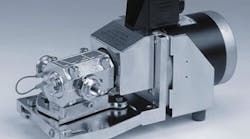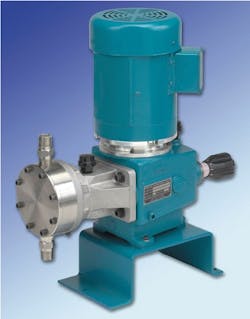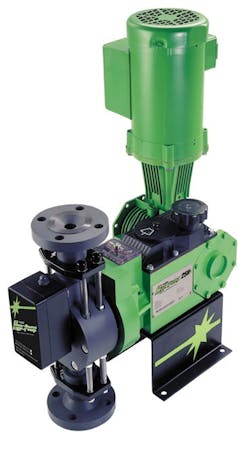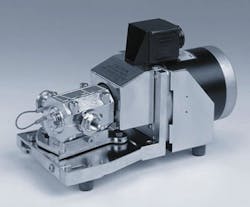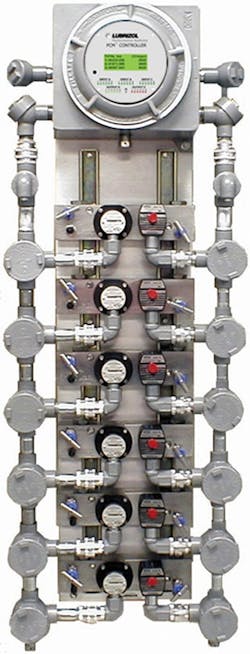Many processing operations require the accurate dosing of liquids such as reactants, ingredients and additives. Vendors offer a multitude of positive-displacement pump designs, using pistons, diaphragms or gears, that compete in performance, reliability and, of course, cost. There seem to be as many variations of metering systems as there are metering applications.
"Our experience is, you start with the flows and loads -- what quantities of chemicals you're mixing or blending, and what product specifications you have to meet," says Craig DeWallace, president of DeWallace Technical Sales, an engineering company in Worcester, Mass. "Then you determine the size of the metering pump and what accuracy you need to maintain. These determine the instrumentation needs. Finally, you factor in the materials of construction needed, both for the pump and the piping and ancillaries."
Depending upon application, users' options can range from buying metering pumps and accessories on their own to contracting for a complete package that includes the chemical additive or component, the dispensing system and necessary maintenance services.
DeWallace's company exemplifies the gradual trend in metering technology: the move toward delivering packaged systems. (For information on skid-mounted process equipment, see the story on p. 28.) Some of the momentum for this trend comes from suppliers of commonly dispensed chemicals, such as water treatment additives, who are trying to provide a complete processing solution, rather than simply sell their chemicals. Pump vendors also have adopted a solutions approach in this hotly competitive environment. In addition, the end users themselves are focusing more on managing their plants and the markets for their products, and less on the engineering design of elements in those plants.
Pulsafeeder Inc., Rochester, N.Y., a division of IDEX Corp., recently acquired Classic Engineering, Jacksonville, Fla., a packaged-systems vendor, to provide engineered metering systems. "People are looking for an entire solution, not just a pump," says Nick Valente, marketing manager at Pulsafeeder.
At Bran+Luebbe, Delavan, Wis., a division of SPX Corp., a similar emphasis on packaged systems is occurring. Several years ago, the company introduced AutoBlend technology -- essentially an engineering service to provide packaged systems for a wide range of process applications. Over the past summer, the parent corporation has reorganized its subsidiaries to form SPX Process Equipment, which encompasses most of the Bran+Luebbe product line, as well as fluid-control products from Waukesha Cherry-Burrell and Lightnin Mixers. "This enables us to leverage what we know in a variety of industries across all our customers," says Allen Daniszewski, manager of process systems for SPX.
Pistons and diaphragms
The tried-and-true metering pump is a positive-displacement, mechanical piston pump, in which the rotary motion of a motor or engine is transformed into a back-and-forth piston motion. The piston displaces a set volume of fluid (at least when the fluid is relatively incompressible) with each stroke. "It's simple and cheap," says Mike Dowse, general manager of Neptune Chemical Pump Inc., Lansdale, Pa.
In recent years, though, diaphragm pumps have played an increasing role. Such units interpose an elastomeric diaphragm between a piston or motive fluid pressurized by a piston and the chamber from which the process fluid is dispensed. The process fluid does not come into contact with the piston, so it doesn't foul the piston and contaminate the fluid.
Pulsafeeder has introduced both hydraulically and mechanically actuated diaphragm pumps for metering applications; the units are called, respectively, the Pulsar HypoPump and Pulsar Shadow. The HypoPump is designed to handle relatively volatile hypochlorite solutions for wastewater treatment, while the Shadow boasts a rugged construction to minimize maintenance.
Meanwhile, Neptune has launched a mechanically actuated diaphragm pump for high-volume, viscous flows (300 gal/hr, viscosity above 5,000 cP) to extend the application range of its product line. "Mechanically actuated diaphragm pumps run cooler than hydraulic ones," Dowse says. "This pump also has the advantage of being self-priming."
Series 7000 mechanically actuated diaphragm metering pump can handle viscosities exceeding 5,000 cP.
Source: Neptune Chemical Pump
At least one systems designer, ChemIndustrial Systems Inc., Cedarburg, Wis., favors use of a centrifugal pump for metering. The pump is paired with a venturi tube; fluid flowing through the venturi draws the additive into the fluid. According to the company, centrifugal pumps are simpler to operate than positive-displacement units. The use of the venturi also means that the additive doesn't come into contact with the pump seals, which are a common wear point for centrifugal pumps. The system is tailored for applications where a chemical is being added to water streams such as those for cooling tower systems, boiler feeds and the like.
Commonly today, whatever the pump design, a variable-frequency drive (VFD) provides the power. Especially where flows are not constant (which is a basic characteristic of metering, after all), the VFD can offer significant energy savings over constant-speed motors.
Smaller, more-precise flows
SPX's Daniszewski sees an interesting trend in metering systems for formulated products: in certain industries, there is a drive toward making a range of products by starting with a "master batch" formulation, to which different additives are mixed, rather than making each variation of the product from scratch. The trend is best seen in consumer packaged goods such as cosmetics. "Manufacturers have rationalized their ingredients, as well as the suppliers of those ingredients," he says. To make, say, five versions of a hair shampoo, a manufacturer might start with the same basic formulation, then add fragrances, conditioners and other ingredients to produce the final product range. This trend affects metering system design by requiring small, precise metering systems, notes Daniszewski. The metering systems must be able to switch from one formulation to another with minimal wastage, and must minimize inaccuracies in metering.
Another supplier of packaged systems, W.J.Wadsworth & Associates, Arlington Heights, Ill., agrees that there is a trend toward smaller, more precise flows, and cites another driver. "In water treatment, which is a market for which we supply many systems, the trend is towards more-concentrated additives," says Len Niemi, president. "Chemical suppliers are seeing better economics in providing undiluted additives, saving on shipping costs." It's hard to say whether better dosing precision has led to the use of more-concentrated additives, or whether the additive suppliers' needs have spurred the equipment developments, but the end result is the same, notes Niemi: metering systems are handling smaller flows of additives or components with better accuracy.
One company poised to take advantage of this trend is Ivek Corp., North Springfield, Vt., which provides pumps and metering systems for liter/min to nanoliter/min ranges, in applications such as pharmaceutical production, food processing and lubrication systems. The company's core product, explains Frank Dimaggio, sales VP, is a reciprocating piston pump, powered by a stepper motor. The piston and its associated chamber are constructed of alumina or zirconia ceramics. The sealless piston pump's components are machined to within 10 millionths of an inch, and get sufficient lubrication from the fluid being pumped so that no other lubrication is needed, says Dimaggio. Using ceramics minimizes fouling while enabling easier cleaning, he adds. The all-digital controls allow for repeatability of 0.1 percent and comparable accuracy. System pressure is limited to around 250 psig to prevent damage to the ceramics.
The Pulsar HypoPump for handling sodium hypochlorite features a patented design that allows pressurized process fluid to flush liquid cyclically through the pump's discharge check system.
Source: Pulsafeeder
Flow control
When it comes to accuracy of metering, most system designers agree: you get what you pay for. A good designer will weigh the need for higher accuracy (and the higher attendant cost) against the process and economic impact of lower, but adequate, accuracy. If a process can tolerate some over- or under-feeding and the additive is not expensive, opting for higher accuracy may not make sense.
The simplest metering applications tend to involve ingredient addition to vessels in batch procesess. Continuous processes, where flow of the primary fluid might vary, add a level of complexity that usually requires closed-loop control, with flow metering of the primary fluid providing a feedback signal to the metering pump to adjust flow. And continuous processes where a key characteristic of the primary fluid does vary (such as the pH of wastewater entering a treatment plant) represent a greater challenge.
Basic flow control of metering systems starts with calibration of the output of the metering pump. (This calibration is also recommended as a routine maintenance check.) Most systems have some type of pulse counter connected to the pump; as long as the volume or mass represented by each pulse is accurately known, the output can measured simply by counting.
Depending upon the severity and variability of the application, simple pulse counting might not suffice. Backpressure also can significantly affect the output of some positive-displacement pumps. In these cases, system vendors provide a variety of flow sensors that measure actual output. Neptune, for example, offers a gear-meter-based "flow checker" in its PZiA line of metering pumps, which allows the user to calibrate the system under actual process conditions, to account for variations in viscosity and pressure.
Split-case pump for metering fluids at rates of up to 2L/min. features a pump module containing precisely machined ceramic parts.
Source: IVEK Corp.
Pulsafeeder's Valente points to its digital logic controller (motor) or DLCM, which uses patented technology to control the stroke length of its hydraulically actuated diaphragm pumps, in addition to the flow output. The combination provides better accuracy and repeatability than systems that control one or the other performance characteristic, but not both, he says.
Wadsworth's Niemi suggests adding another flow element when designing a metering system: a pulsation dampener. It is a type of valve that reduces the spike in pressure with rotary or piston-driven pumps. "If the downstream gauges see that spike, it will eventually cause them to wear out," he says. "You get more trouble-free operation when a dampener is specified."
Metering systems can be arranged with multiple pumps or with multiple feedlines coming from one or more pumps and serving a group of vessels. Craig DeWallace recommends the use of a large-capacity pump for moving the bulk of the fluid to a vessel, and then another, more precise pump for reaching the desired output-such as for addition of a caustic solution to neutralize a wastewater stream at a treatment plant. His company has built systems with an air-operated double-diaphragm pump to move a large quantity of neutralizing solution quickly, plus a metering pump to provide the finishing amount.
Mini-Pak manifold provides metering accuracy to 0.1% even at flowrates of over 600 gal./min.
Source: Lubrizol Performance Systems
Multiple feeds from a pump usually are routed through some type of manifold, and that manifold provides another point where flow control is possible. This is the design philosophy behind a product line from the Performance Systems Div. of Lubrizol Corp., Atlanta. The business grew out of Lubrizol's need to develop systems to inject additives into gasoline at fuel terminals -- where it retains a leading market share -- and now encompasses food processing, downstream oil production, defoaming and other applications.
Its Mini-Pak injector is a machined block of metal with ports for feedstreams, and connections to a solenoid valve, a gear-based flowmeter, and communications modules. The typical application, says Bill Silzle, division president, is for controlling the addition of a small quantity of an expensive component -- such as the dyes used in retail gasoline -- to a large flowstream, such as the fuel being dispensed into a delivery truck at a fuel terminal. The injector's flowmeter divides the flow into thousands of pulses, which are counted electronically and totalized for the desired flow input. Silzle says that the unit achieves metering accuracy to within 0.1%, even with flowrates in excess of 600 gal/min.
